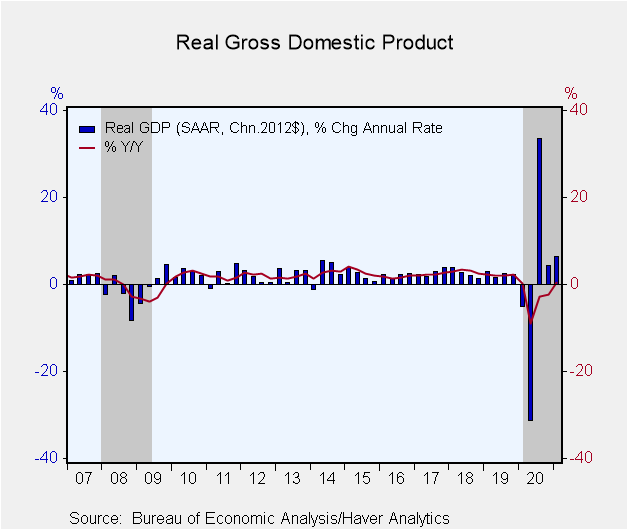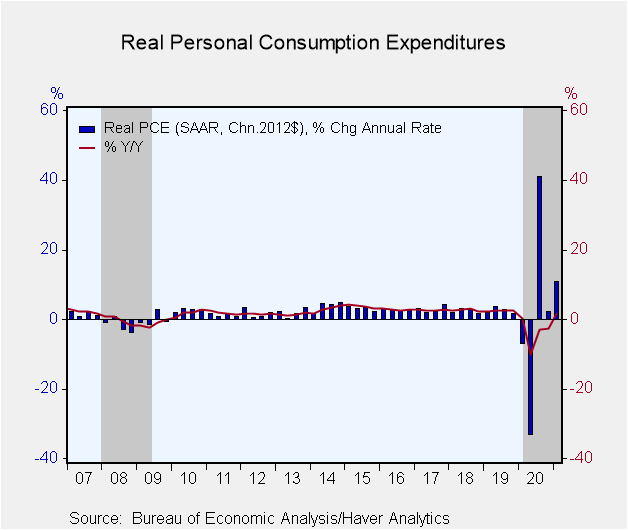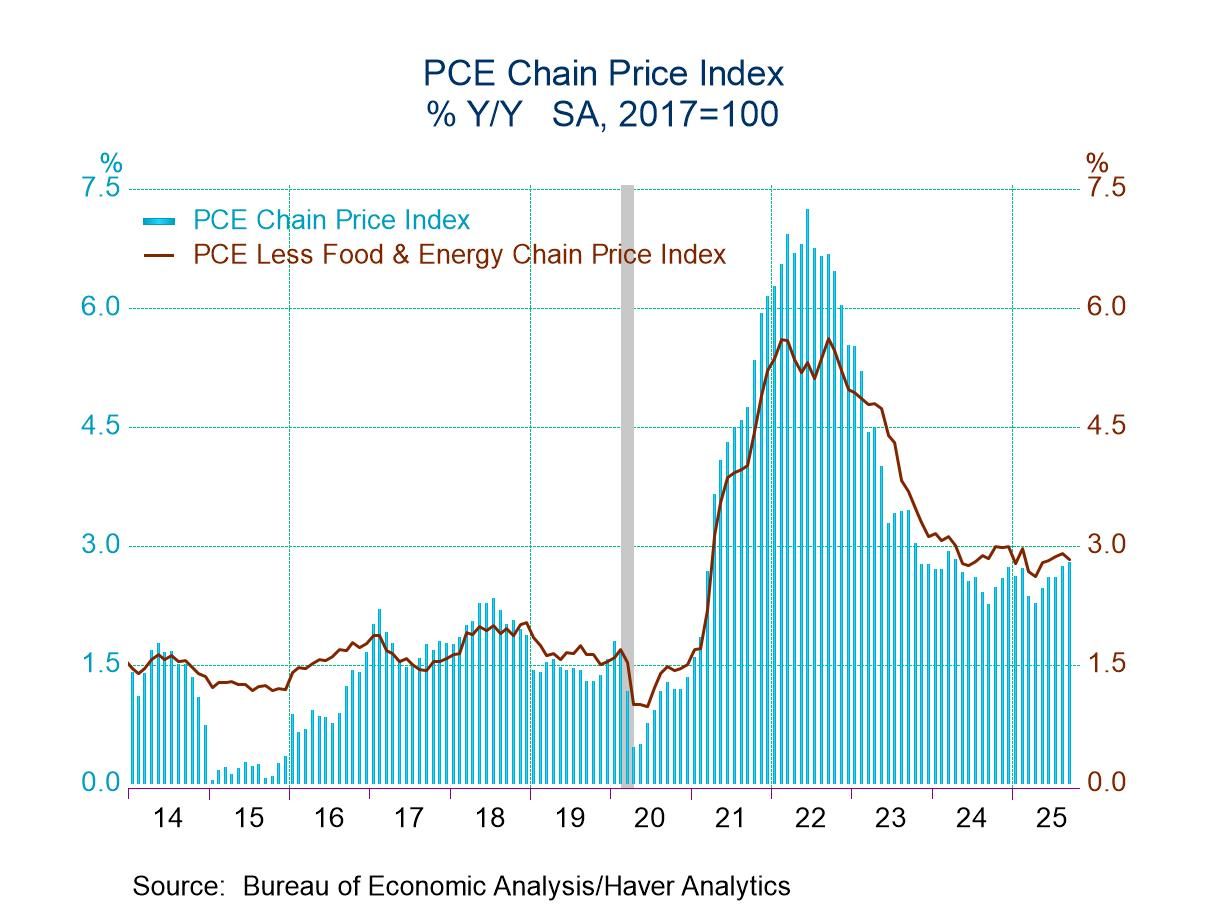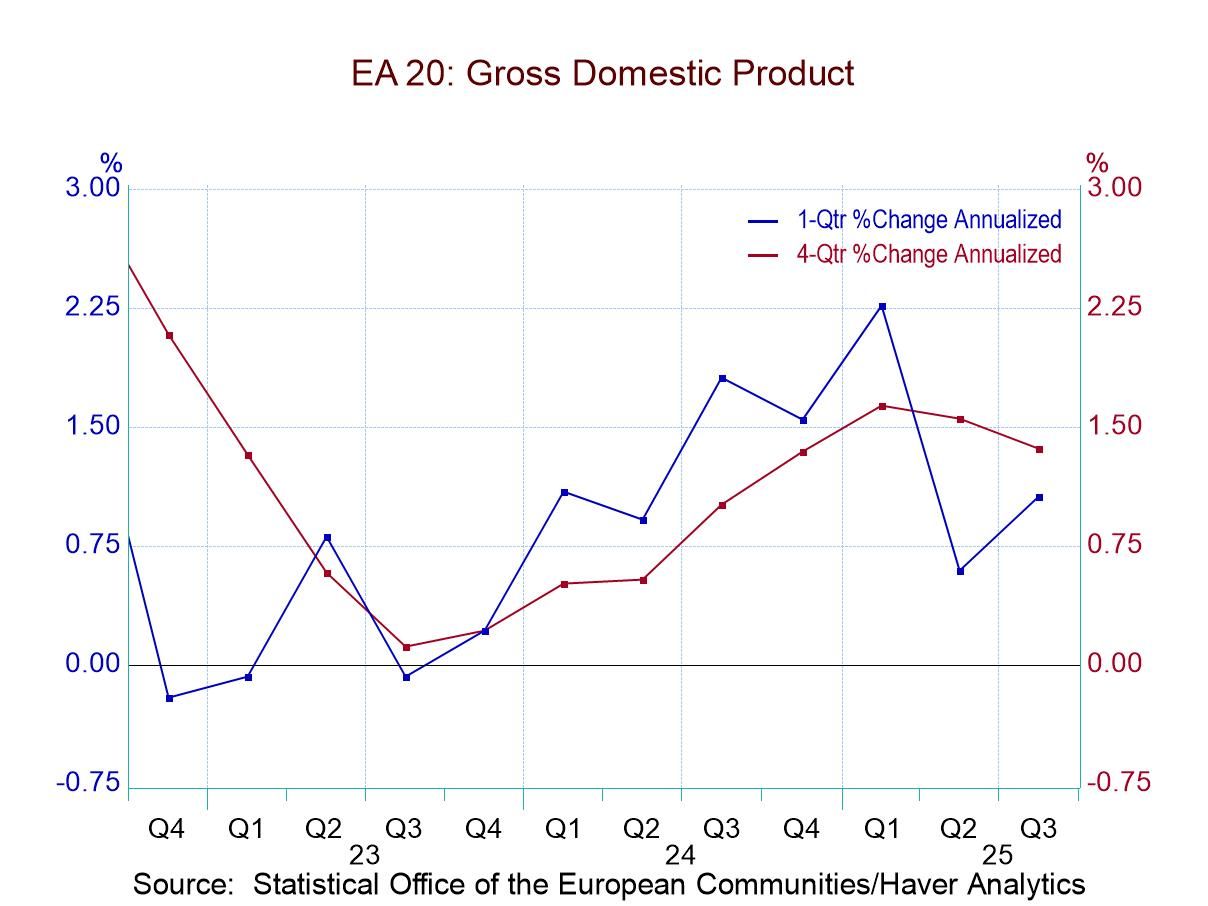 Global| Apr 29 2021
Global| Apr 29 2021U.S. GDP Growth Acceleration Paced by the Consumer
by:Tom Moeller
|in:Economy in Brief
Summary
• Cash payments, vaccinations and reduced business restrictions lift consumer spending. • Business investment surges, again • Price index is lifted by energy and housing. Trillions of dollars in government aid as well as widespread [...]
• Cash payments, vaccinations and reduced business restrictions lift consumer spending.
• Business investment surges, again
• Price index is lifted by energy and housing.
Trillions of dollars in government aid as well as widespread COVID-19 shots prompted consumers to spend more last quarter. Real GDP surged 6.4% (SAAR) during Q1'21 (0.4% y/y) following a 4.3% rise during the previous quarter. A 6.0% gain had been expected in the Action Economics Forecast Survey.
Domestic final sales growth more-than doubled q/q as consumer spending surged 10.7% (1.6% y/y) following a 2.3% Q4 rise. Durable goods spending jumped 41.4% (+25.9% y/y) after easing 1.1% in Q4. Nondurable goods spending strengthened 14.4% (5.8% y/y) following a 1.6% decline. Outlays on services increased 4.6% (-3.2% y/y) following a 4.3% rise.
Business fixed investment grew 9.9% (2.7% y/y), the third straight quarter of strong growth. Residential investment surged 10.8% (12.3% y/y) to the highest level since the first quarter of 2007.
The GDP chain price index rose 4.1% (1.9% y/y), the strongest gain since Q1'07. The PCE price index accelerated to 3.5% (1.7% y/y) while business fixed investment prices rose 0.5% (0.4% y/y) after a 0.2% gain. The residential investment price index surged 11.4% (7.0% y/y) while the public sector price index strengthened 6.2% (2.4% y/y), equaling the largest gain since early 2007.
The GDP figures can be found in Haver's USECON and USNA database. USNA contains virtually all of the Bureau of Economic Analysis' detail in the national accounts. Both databases include tables of the newly published not seasonally adjusted data. The Action Economics consensus estimates can be found in AS1REPNA.
| Chained 2012 $ (%, AR) | Q1'21 | Q4'20 | Q3'20 | Q1'21 Y/Y | 2020 | 2019 | 2018 |
|---|---|---|---|---|---|---|---|
| Gross Domestic Product | 6.4 | 4.3 | 33.4 | 0.4 | -3.5 | 2.2 | 3.0 |
| Inventory Effect (%-point) | -2.6 | 1.4 | 6.6 | 0.0 | -0.6 | 0.0 | 0.2 |
| Final Sales | 9.2 | 2.9 | 25.9 | 0.4 | -2.9 | 2.2 | 2.8 |
| Foreign Trade Effect (%-point) | -0.9 | -1.5 | -3.2 | -1.6 | -0.1 | -0.2 | -0.3 |
| Domestic Final Sales | 9.8 | 4.4 | 29.8 | 2.0 | -2.7 | 2.3 | 3.0 |
| Demand Components | |||||||
| Personal Consumption Expenditure | 10.7 | 2.3 | 41.0 | 1.6 | -3.9 | 2.4 | 2.7 |
| Nonresidential Fixed Investment | 9.9 | 13.1 | 22.9 | 2.7 | -4.0 | 2.9 | 6.9 |
| Residential Investment | 10.8 | 36.6 | 63.0 | 12.3 | 6.1 | -1.7 | -0.6 |
| Government Spending | 6.3 | -0.8 | -4.8 | 0.7 | 1.1 | 2.3 | 1.8 |
| Chain-Type Price Index | |||||||
| GDP | 4.1 | 2.0 | 3.5 | 1.9 | 1.2 | 1.8 | 2.4 |
| Personal Consumption Expenditure | 3.5 | 1.5 | 3.7 | 1.7 | 1.2 | 1.5 | 2.1 |
| Less Food & Energy | 2.3 | 1.3 | 3.4 | 1.5 | 1.4 | 1.7 | 2.0 |
| Nonresidential Investment | 0.5 | 0.2 | 0.1 | 0.4 | 0.5 | 1.3 | 0.9 |
| Residential Investment | 11.4 | 6.5 | 9.5 | 7.0 | 3.3 | 2.8 | 5.6 |
Tom Moeller
AuthorMore in Author Profile »Prior to joining Haver Analytics in 2000, Mr. Moeller worked as the Economist at Chancellor Capital Management from 1985 to 1999. There, he developed comprehensive economic forecasts and interpreted economic data for equity and fixed income portfolio managers. Also at Chancellor, Mr. Moeller worked as an equity analyst and was responsible for researching and rating companies in the economically sensitive automobile and housing industries for investment in Chancellor’s equity portfolio. Prior to joining Chancellor, Mr. Moeller was an Economist at Citibank from 1979 to 1984. He also analyzed pricing behavior in the metals industry for the Council on Wage and Price Stability in Washington, D.C. In 1999, Mr. Moeller received the award for most accurate forecast from the Forecasters' Club of New York. From 1990 to 1992 he was President of the New York Association for Business Economists. Mr. Moeller earned an M.B.A. in Finance from Fordham University, where he graduated in 1987. He holds a Bachelor of Arts in Economics from George Washington University.








